US History: World War 2 Battle of Midway and Aichi D3A Val Analysis
VerifiedAdded on 2023/01/13
|11
|3363
|60
Essay
AI Summary
This essay provides a detailed overview of the World War II Battle of Midway and the Aichi D3A Val dive bomber. It begins by setting the stage with the origins of World War II, highlighting key events such as Germany's invasion of Poland and the Battle of Guadalcanal. The essay then focuses on the Pacific theater, examining Japan's strategic goals and the pivotal role of oil resources. It delves into the internal conflicts within the Imperial Japanese Navy, the strategic planning of Admiral Isoroku Yamamoto, and the Doolittle Raid. The analysis explores the Aichi D3A Val dive bomber's use in the attack on Pearl Harbor, the Japanese strategy to attack Midway, and the U.S. Navy's decryption of Japanese codes. The essay details the roles of key figures like Admiral Chester W. Nimitz and the events leading up to the battle, including the damaged USS Yorktown's repair. Finally, the essay describes the battle itself, including the Japanese losses, the crucial decisions made by Admiral Nagumo, and the development of dive bombers and their importance in warfare.
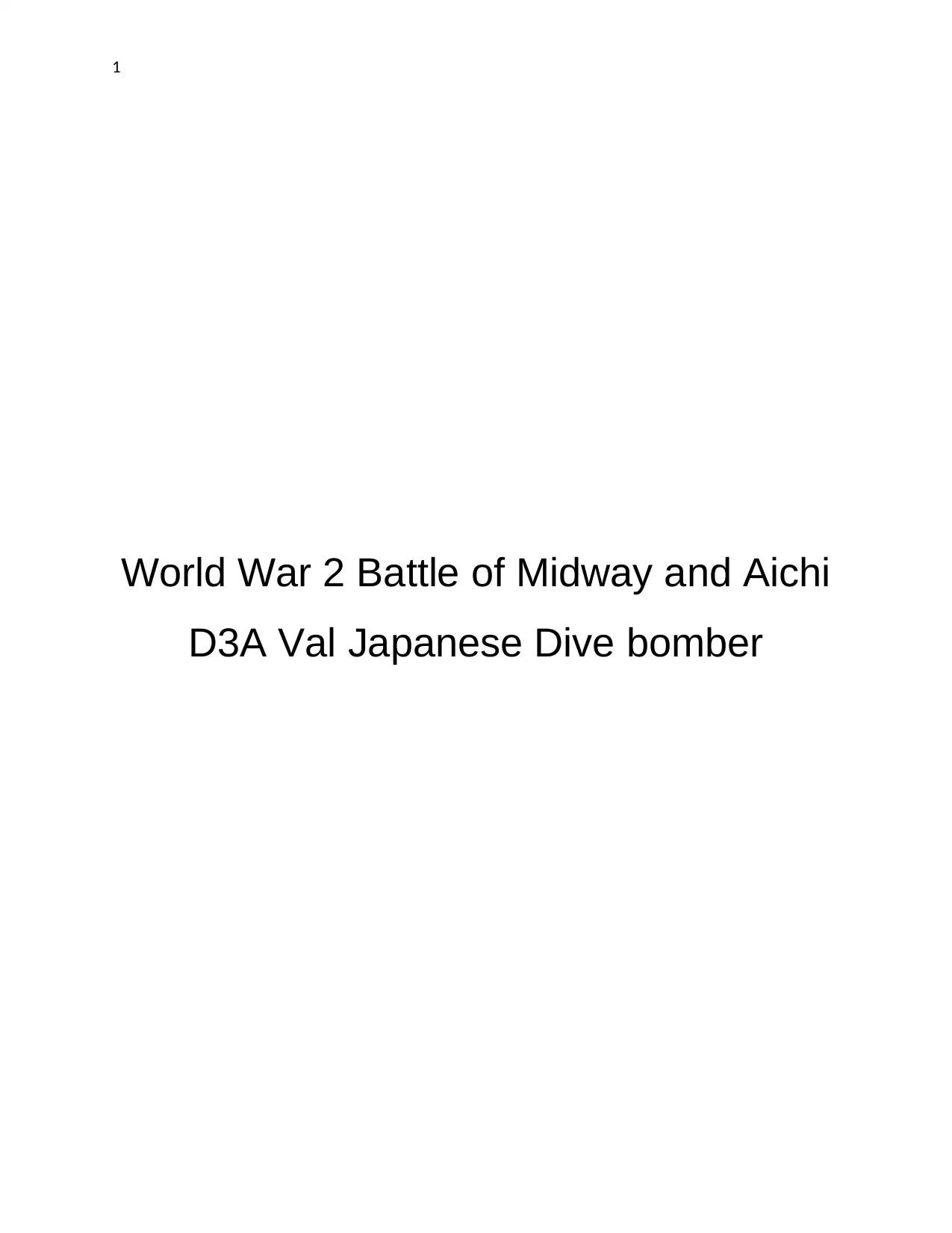
1
World War 2 Battle of Midway and Aichi
D3A Val Japanese Dive bomber
World War 2 Battle of Midway and Aichi
D3A Val Japanese Dive bomber
Paraphrase This Document
Need a fresh take? Get an instant paraphrase of this document with our AI Paraphraser

2
Table of Contents
World War II Battle of Midway and Aichi D3A Val summary.......................................................................3
Table of Contents
World War II Battle of Midway and Aichi D3A Val summary.......................................................................3
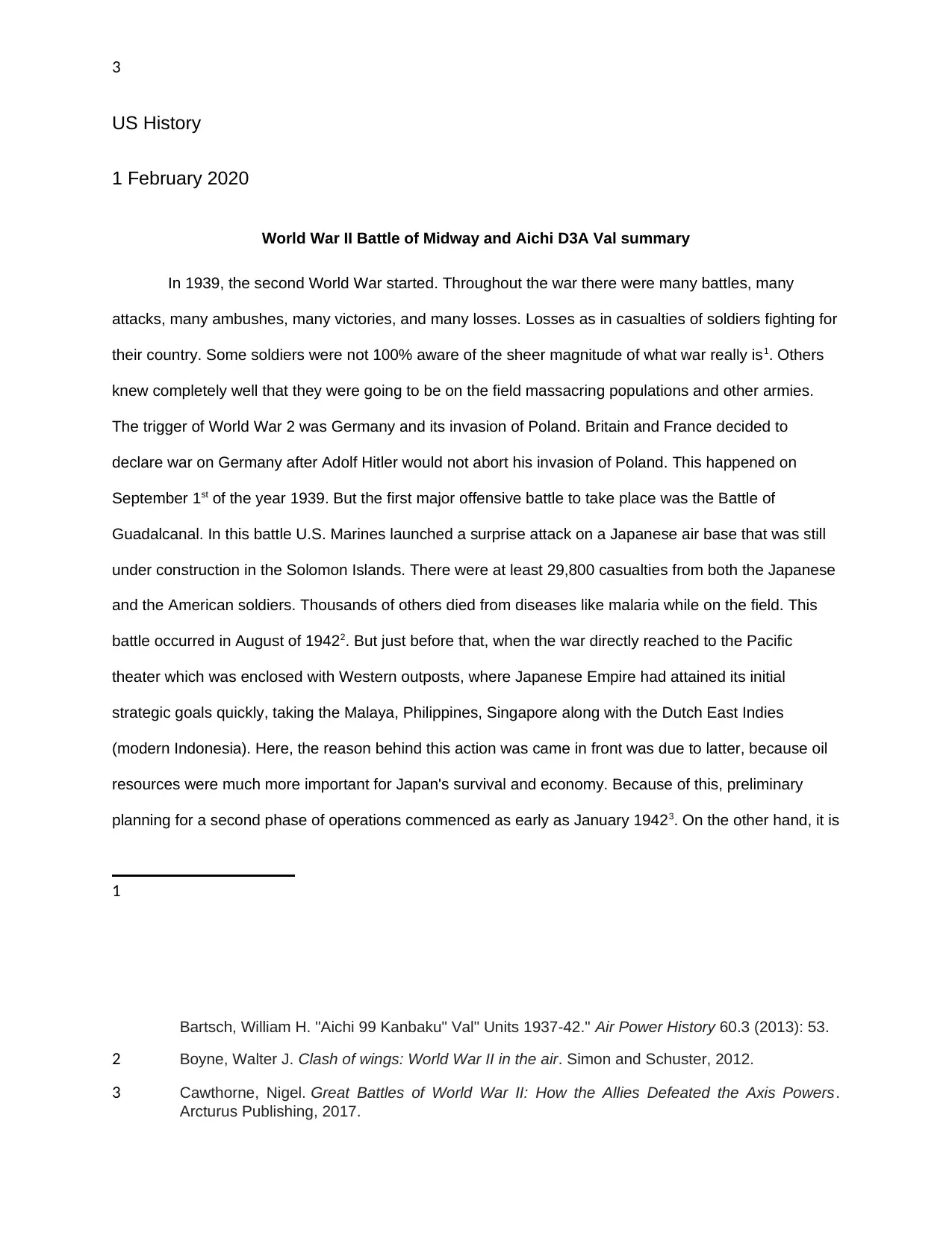
3
US History
1 February 2020
World War II Battle of Midway and Aichi D3A Val summary
In 1939, the second World War started. Throughout the war there were many battles, many
attacks, many ambushes, many victories, and many losses. Losses as in casualties of soldiers fighting for
their country. Some soldiers were not 100% aware of the sheer magnitude of what war really is1. Others
knew completely well that they were going to be on the field massacring populations and other armies.
The trigger of World War 2 was Germany and its invasion of Poland. Britain and France decided to
declare war on Germany after Adolf Hitler would not abort his invasion of Poland. This happened on
September 1st of the year 1939. But the first major offensive battle to take place was the Battle of
Guadalcanal. In this battle U.S. Marines launched a surprise attack on a Japanese air base that was still
under construction in the Solomon Islands. There were at least 29,800 casualties from both the Japanese
and the American soldiers. Thousands of others died from diseases like malaria while on the field. This
battle occurred in August of 19422. But just before that, when the war directly reached to the Pacific
theater which was enclosed with Western outposts, where Japanese Empire had attained its initial
strategic goals quickly, taking the Malaya, Philippines, Singapore along with the Dutch East Indies
(modern Indonesia). Here, the reason behind this action was came in front was due to latter, because oil
resources were much more important for Japan's survival and economy. Because of this, preliminary
planning for a second phase of operations commenced as early as January 19423. On the other hand, it is
1
Bartsch, William H. "Aichi 99 Kanbaku" Val" Units 1937-42." Air Power History 60.3 (2013): 53.
2 Boyne, Walter J. Clash of wings: World War II in the air. Simon and Schuster, 2012.
3 Cawthorne, Nigel. Great Battles of World War II: How the Allies Defeated the Axis Powers.
Arcturus Publishing, 2017.
US History
1 February 2020
World War II Battle of Midway and Aichi D3A Val summary
In 1939, the second World War started. Throughout the war there were many battles, many
attacks, many ambushes, many victories, and many losses. Losses as in casualties of soldiers fighting for
their country. Some soldiers were not 100% aware of the sheer magnitude of what war really is1. Others
knew completely well that they were going to be on the field massacring populations and other armies.
The trigger of World War 2 was Germany and its invasion of Poland. Britain and France decided to
declare war on Germany after Adolf Hitler would not abort his invasion of Poland. This happened on
September 1st of the year 1939. But the first major offensive battle to take place was the Battle of
Guadalcanal. In this battle U.S. Marines launched a surprise attack on a Japanese air base that was still
under construction in the Solomon Islands. There were at least 29,800 casualties from both the Japanese
and the American soldiers. Thousands of others died from diseases like malaria while on the field. This
battle occurred in August of 19422. But just before that, when the war directly reached to the Pacific
theater which was enclosed with Western outposts, where Japanese Empire had attained its initial
strategic goals quickly, taking the Malaya, Philippines, Singapore along with the Dutch East Indies
(modern Indonesia). Here, the reason behind this action was came in front was due to latter, because oil
resources were much more important for Japan's survival and economy. Because of this, preliminary
planning for a second phase of operations commenced as early as January 19423. On the other hand, it is
1
Bartsch, William H. "Aichi 99 Kanbaku" Val" Units 1937-42." Air Power History 60.3 (2013): 53.
2 Boyne, Walter J. Clash of wings: World War II in the air. Simon and Schuster, 2012.
3 Cawthorne, Nigel. Great Battles of World War II: How the Allies Defeated the Axis Powers.
Arcturus Publishing, 2017.
⊘ This is a preview!⊘
Do you want full access?
Subscribe today to unlock all pages.

Trusted by 1+ million students worldwide

4
also said that among Imperial Navy (IJN), Imperial Army (IJA) along with the infighting among Navy's
GHQ has brought high range of strategic differences.
This is where some of the major individuals within the Naval Army like Admiral Isoroku
Yamamoto, Chuichi Nagumo, Nobutake Kondo took number of decisions in order to develop a strategy to
win the battle. Under this situation, there were many arguments took place, where the bureaucratic
struggle was specifically won by Isoroku Yamamoto4. This is where, he planned to conduct the strategic
battle on Central Pacific. Specifically, it was the admiral's plan to eliminate America's carrier forces, which
was being considered as one of the crucial threat for the developed Pacific campaign. Including this, it is
said that concern, which was taken into consideration by Yamamoto was specifically linked within
Doolittle Raid, which was done on April 18, 1942, where by U.S. Army Air Forces B-25 Mitchell bombers
launched from USS Hornet bombed targets in Tokyo few other cities of Japan. But, this was the repulsive
reaction of U.S. Army of the attack that Japan did on Pearl Harbor5. This is where, Japanese utilized Aichi
D3A (Vals) which can be considered as primal most and first aircraft to utilize bomb against America
where, the targets were Pearl Harbor & United States base that they built in Philippines, like Clark Air
Force Base. Other name of Aichi D3A was (Vals) which mostly sank various warships than any other Axis
aircraft6.
Returning to the situation, where it was left where number of militarily insignificant, is being
considered as a shock for Japan, which raised ample number of questions on defenses. In present
context, this was considered as one of the major threat for Japan, where Yamamoto already knew that if
appropriate action is not going to be made in short period, then the belief and of citizens would directly
loose the trust7. Apparently unwilling because to be dragged from an all-out war. Yamamoto argued that
attack against the key U.S. Navy base at Pearl Harbor will cause the entire American navy, such as the
4 Matic, Ashley. "The Trash Pile'Zeke': The identification of the remains of a Mitsubishi A6M Zero
in a rubbish dump, Yaren District, Republic of Nauru." Artefact: the Journal of the
Archaeological and Anthropological Society of Victoria, The 41 (2018): 16.
5 Cleaver, Thomas McKelvey. F4f Wildcat and F6f Hellcat Aces of Vf-2. Bloomsbury Publishing,
2015.
6 Hallion, Richard P. "History of Rocketry and Astronautics: Proceedings of the 41st History
Symposium of the International Academy of Astronautics, Hyderabad, Andhra, India, 2007; v.
38 of the AAS History Series, and v. 27 of the IAA History Symposia." Air Power History 60.3
(2013): 52.
also said that among Imperial Navy (IJN), Imperial Army (IJA) along with the infighting among Navy's
GHQ has brought high range of strategic differences.
This is where some of the major individuals within the Naval Army like Admiral Isoroku
Yamamoto, Chuichi Nagumo, Nobutake Kondo took number of decisions in order to develop a strategy to
win the battle. Under this situation, there were many arguments took place, where the bureaucratic
struggle was specifically won by Isoroku Yamamoto4. This is where, he planned to conduct the strategic
battle on Central Pacific. Specifically, it was the admiral's plan to eliminate America's carrier forces, which
was being considered as one of the crucial threat for the developed Pacific campaign. Including this, it is
said that concern, which was taken into consideration by Yamamoto was specifically linked within
Doolittle Raid, which was done on April 18, 1942, where by U.S. Army Air Forces B-25 Mitchell bombers
launched from USS Hornet bombed targets in Tokyo few other cities of Japan. But, this was the repulsive
reaction of U.S. Army of the attack that Japan did on Pearl Harbor5. This is where, Japanese utilized Aichi
D3A (Vals) which can be considered as primal most and first aircraft to utilize bomb against America
where, the targets were Pearl Harbor & United States base that they built in Philippines, like Clark Air
Force Base. Other name of Aichi D3A was (Vals) which mostly sank various warships than any other Axis
aircraft6.
Returning to the situation, where it was left where number of militarily insignificant, is being
considered as a shock for Japan, which raised ample number of questions on defenses. In present
context, this was considered as one of the major threat for Japan, where Yamamoto already knew that if
appropriate action is not going to be made in short period, then the belief and of citizens would directly
loose the trust7. Apparently unwilling because to be dragged from an all-out war. Yamamoto argued that
attack against the key U.S. Navy base at Pearl Harbor will cause the entire American navy, such as the
4 Matic, Ashley. "The Trash Pile'Zeke': The identification of the remains of a Mitsubishi A6M Zero
in a rubbish dump, Yaren District, Republic of Nauru." Artefact: the Journal of the
Archaeological and Anthropological Society of Victoria, The 41 (2018): 16.
5 Cleaver, Thomas McKelvey. F4f Wildcat and F6f Hellcat Aces of Vf-2. Bloomsbury Publishing,
2015.
6 Hallion, Richard P. "History of Rocketry and Astronautics: Proceedings of the 41st History
Symposium of the International Academy of Astronautics, Hyderabad, Andhra, India, 2007; v.
38 of the AAS History Series, and v. 27 of the IAA History Symposia." Air Power History 60.3
(2013): 52.
Paraphrase This Document
Need a fresh take? Get an instant paraphrase of this document with our AI Paraphraser
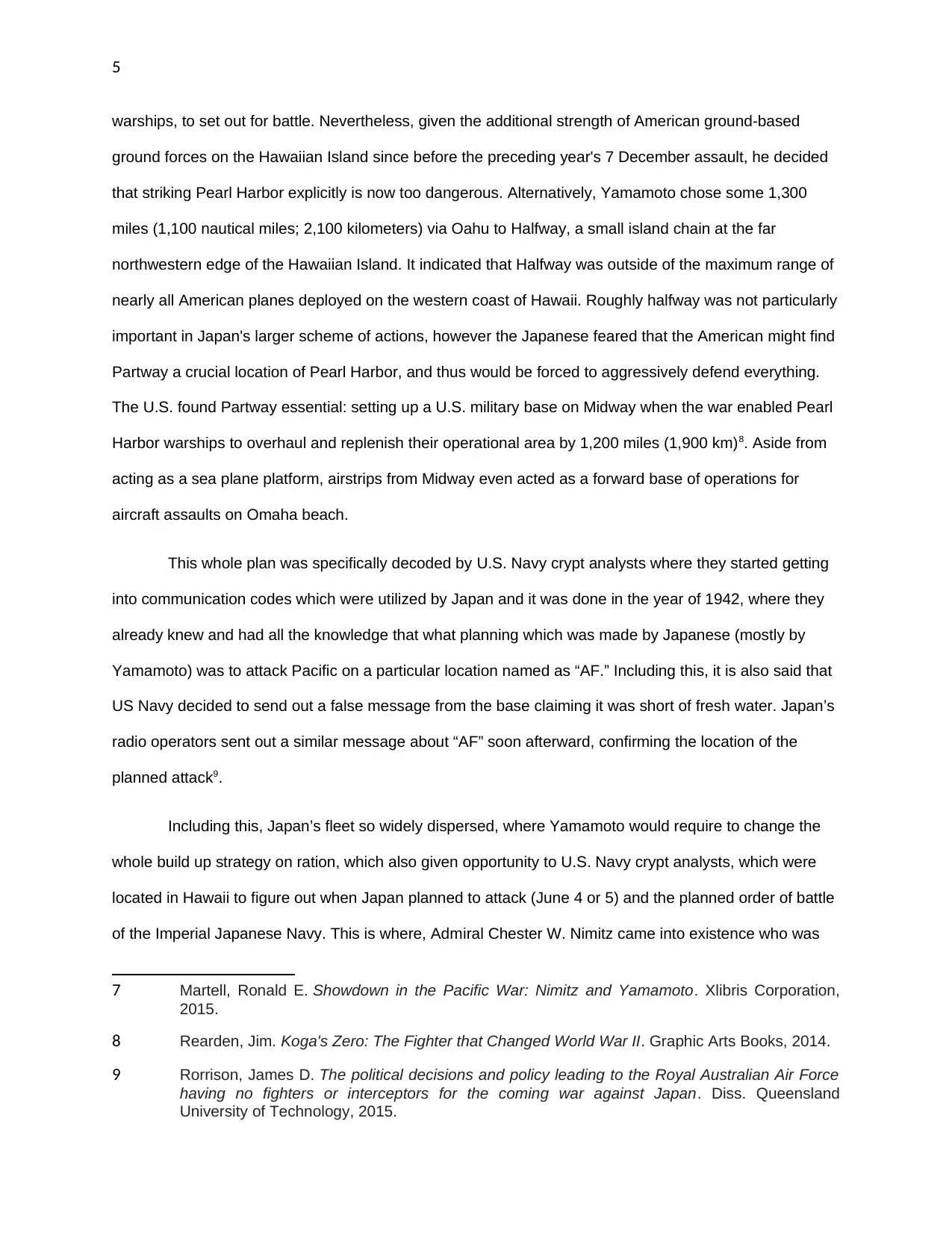
5
warships, to set out for battle. Nevertheless, given the additional strength of American ground-based
ground forces on the Hawaiian Island since before the preceding year's 7 December assault, he decided
that striking Pearl Harbor explicitly is now too dangerous. Alternatively, Yamamoto chose some 1,300
miles (1,100 nautical miles; 2,100 kilometers) via Oahu to Halfway, a small island chain at the far
northwestern edge of the Hawaiian Island. It indicated that Halfway was outside of the maximum range of
nearly all American planes deployed on the western coast of Hawaii. Roughly halfway was not particularly
important in Japan's larger scheme of actions, however the Japanese feared that the American might find
Partway a crucial location of Pearl Harbor, and thus would be forced to aggressively defend everything.
The U.S. found Partway essential: setting up a U.S. military base on Midway when the war enabled Pearl
Harbor warships to overhaul and replenish their operational area by 1,200 miles (1,900 km)8. Aside from
acting as a sea plane platform, airstrips from Midway even acted as a forward base of operations for
aircraft assaults on Omaha beach.
This whole plan was specifically decoded by U.S. Navy crypt analysts where they started getting
into communication codes which were utilized by Japan and it was done in the year of 1942, where they
already knew and had all the knowledge that what planning which was made by Japanese (mostly by
Yamamoto) was to attack Pacific on a particular location named as “AF.” Including this, it is also said that
US Navy decided to send out a false message from the base claiming it was short of fresh water. Japan’s
radio operators sent out a similar message about “AF” soon afterward, confirming the location of the
planned attack9.
Including this, Japan’s fleet so widely dispersed, where Yamamoto would require to change the
whole build up strategy on ration, which also given opportunity to U.S. Navy crypt analysts, which were
located in Hawaii to figure out when Japan planned to attack (June 4 or 5) and the planned order of battle
of the Imperial Japanese Navy. This is where, Admiral Chester W. Nimitz came into existence who was
7 Martell, Ronald E. Showdown in the Pacific War: Nimitz and Yamamoto. Xlibris Corporation,
2015.
8 Rearden, Jim. Koga's Zero: The Fighter that Changed World War II. Graphic Arts Books, 2014.
9 Rorrison, James D. The political decisions and policy leading to the Royal Australian Air Force
having no fighters or interceptors for the coming war against Japan. Diss. Queensland
University of Technology, 2015.
warships, to set out for battle. Nevertheless, given the additional strength of American ground-based
ground forces on the Hawaiian Island since before the preceding year's 7 December assault, he decided
that striking Pearl Harbor explicitly is now too dangerous. Alternatively, Yamamoto chose some 1,300
miles (1,100 nautical miles; 2,100 kilometers) via Oahu to Halfway, a small island chain at the far
northwestern edge of the Hawaiian Island. It indicated that Halfway was outside of the maximum range of
nearly all American planes deployed on the western coast of Hawaii. Roughly halfway was not particularly
important in Japan's larger scheme of actions, however the Japanese feared that the American might find
Partway a crucial location of Pearl Harbor, and thus would be forced to aggressively defend everything.
The U.S. found Partway essential: setting up a U.S. military base on Midway when the war enabled Pearl
Harbor warships to overhaul and replenish their operational area by 1,200 miles (1,900 km)8. Aside from
acting as a sea plane platform, airstrips from Midway even acted as a forward base of operations for
aircraft assaults on Omaha beach.
This whole plan was specifically decoded by U.S. Navy crypt analysts where they started getting
into communication codes which were utilized by Japan and it was done in the year of 1942, where they
already knew and had all the knowledge that what planning which was made by Japanese (mostly by
Yamamoto) was to attack Pacific on a particular location named as “AF.” Including this, it is also said that
US Navy decided to send out a false message from the base claiming it was short of fresh water. Japan’s
radio operators sent out a similar message about “AF” soon afterward, confirming the location of the
planned attack9.
Including this, Japan’s fleet so widely dispersed, where Yamamoto would require to change the
whole build up strategy on ration, which also given opportunity to U.S. Navy crypt analysts, which were
located in Hawaii to figure out when Japan planned to attack (June 4 or 5) and the planned order of battle
of the Imperial Japanese Navy. This is where, Admiral Chester W. Nimitz came into existence who was
7 Martell, Ronald E. Showdown in the Pacific War: Nimitz and Yamamoto. Xlibris Corporation,
2015.
8 Rearden, Jim. Koga's Zero: The Fighter that Changed World War II. Graphic Arts Books, 2014.
9 Rorrison, James D. The political decisions and policy leading to the Royal Australian Air Force
having no fighters or interceptors for the coming war against Japan. Diss. Queensland
University of Technology, 2015.

6
the commander in chief of United States, Pacific Fleet, which would have developed a specific plan in
relation attack invasion10. Away with this, this is being considered as the phase where, Japanese got
confused and through of U.S. aircraft carrier named as Yorktown, that got heavily affected by Battle of the
Coral Sea, may become unavailable at Midway11. Including this, it was found that damaged carrier which
Japanese were thought that it wasn't repaired got brace within the time span of two days. Specifically this
was done at Pearl Harbor Navy Yard12. This was the primal step, which was taken by U.S. Navy and
resulted into number of positive outcomes in specified time frame. In the month of May 27, 1942, after
sailing 3,000 kilometers around the Ocean, the USS Yorktown fought against Pearl Harbor. Throughout
the Defense of the Southern ocean, a 551-pound Japanese blast hit the wood control tower of the
Yorktown, breaking thru and crashing inside the container. About 1,400 repairers worked extremely hard,
installing the Yorktown gaps with metal plates to get it prepared for Nimitz at Midway. Only scarcely 48
hours at the Pearl Harbor Inner harbor in Drydock Amount One, the Yorktown boiled out to follow the
Hornet and Enterprise 325 miles to the north of Midway, at a designated gathering place known as "Point
Luck. The appearance of the Yorktown threw Japanese by astonishment; they initially presumed the
destroyer had been discarded about in the North Atlantic. On June 7, 1942, the Yorktown sunk Japanese
attacks by attackers and warships, but not before it appeared to play an important role in the Allied
invasion at Part way. Basically, what happened in the last in the Battle of Midway, was that Japan lost
four carriers, a cruiser, and 292 aircraft, and suffered 2,500 casualties. While Midway was absorbing the
full force of the Japanese assault, land-based planes from Midway were converging on the Japanese
fleet. Just after 7:00 AM a quartet of U.S. Army Air Forces Martin B-26 Marauders began a torpedo attack
run on the Akagi, Nagumo’s flagship. They were closely followed by six U.S. Navy Grumman TBF
Avenger torpedo bombers. Most of the American planes were shot down in the attempt, and none scored
hits, a fact that owed much to the dismal performance of U.S. Mark 13 torpedoes. The Imperial Japanese
Navy, conversely, fielded aerial and surface torpedoes of outstanding quality, and the Japanese would
retain the technological advantage in this area until the end of the war.
10 Tagaya, Osamu. Aichi 99 Kanbaku'Val'Units: 1937-42. Bloomsbury Publishing, 2013.
11 Stille, Mark. The Imperial Japanese Navy in the Pacific War. Bloomsbury Publishing, 2014.
12 Smith, Peter C. Mitsubishi Zero: Japan's Legendary Fighter. Pen and Sword, 2014.
the commander in chief of United States, Pacific Fleet, which would have developed a specific plan in
relation attack invasion10. Away with this, this is being considered as the phase where, Japanese got
confused and through of U.S. aircraft carrier named as Yorktown, that got heavily affected by Battle of the
Coral Sea, may become unavailable at Midway11. Including this, it was found that damaged carrier which
Japanese were thought that it wasn't repaired got brace within the time span of two days. Specifically this
was done at Pearl Harbor Navy Yard12. This was the primal step, which was taken by U.S. Navy and
resulted into number of positive outcomes in specified time frame. In the month of May 27, 1942, after
sailing 3,000 kilometers around the Ocean, the USS Yorktown fought against Pearl Harbor. Throughout
the Defense of the Southern ocean, a 551-pound Japanese blast hit the wood control tower of the
Yorktown, breaking thru and crashing inside the container. About 1,400 repairers worked extremely hard,
installing the Yorktown gaps with metal plates to get it prepared for Nimitz at Midway. Only scarcely 48
hours at the Pearl Harbor Inner harbor in Drydock Amount One, the Yorktown boiled out to follow the
Hornet and Enterprise 325 miles to the north of Midway, at a designated gathering place known as "Point
Luck. The appearance of the Yorktown threw Japanese by astonishment; they initially presumed the
destroyer had been discarded about in the North Atlantic. On June 7, 1942, the Yorktown sunk Japanese
attacks by attackers and warships, but not before it appeared to play an important role in the Allied
invasion at Part way. Basically, what happened in the last in the Battle of Midway, was that Japan lost
four carriers, a cruiser, and 292 aircraft, and suffered 2,500 casualties. While Midway was absorbing the
full force of the Japanese assault, land-based planes from Midway were converging on the Japanese
fleet. Just after 7:00 AM a quartet of U.S. Army Air Forces Martin B-26 Marauders began a torpedo attack
run on the Akagi, Nagumo’s flagship. They were closely followed by six U.S. Navy Grumman TBF
Avenger torpedo bombers. Most of the American planes were shot down in the attempt, and none scored
hits, a fact that owed much to the dismal performance of U.S. Mark 13 torpedoes. The Imperial Japanese
Navy, conversely, fielded aerial and surface torpedoes of outstanding quality, and the Japanese would
retain the technological advantage in this area until the end of the war.
10 Tagaya, Osamu. Aichi 99 Kanbaku'Val'Units: 1937-42. Bloomsbury Publishing, 2013.
11 Stille, Mark. The Imperial Japanese Navy in the Pacific War. Bloomsbury Publishing, 2014.
12 Smith, Peter C. Mitsubishi Zero: Japan's Legendary Fighter. Pen and Sword, 2014.
⊘ This is a preview!⊘
Do you want full access?
Subscribe today to unlock all pages.

Trusted by 1+ million students worldwide
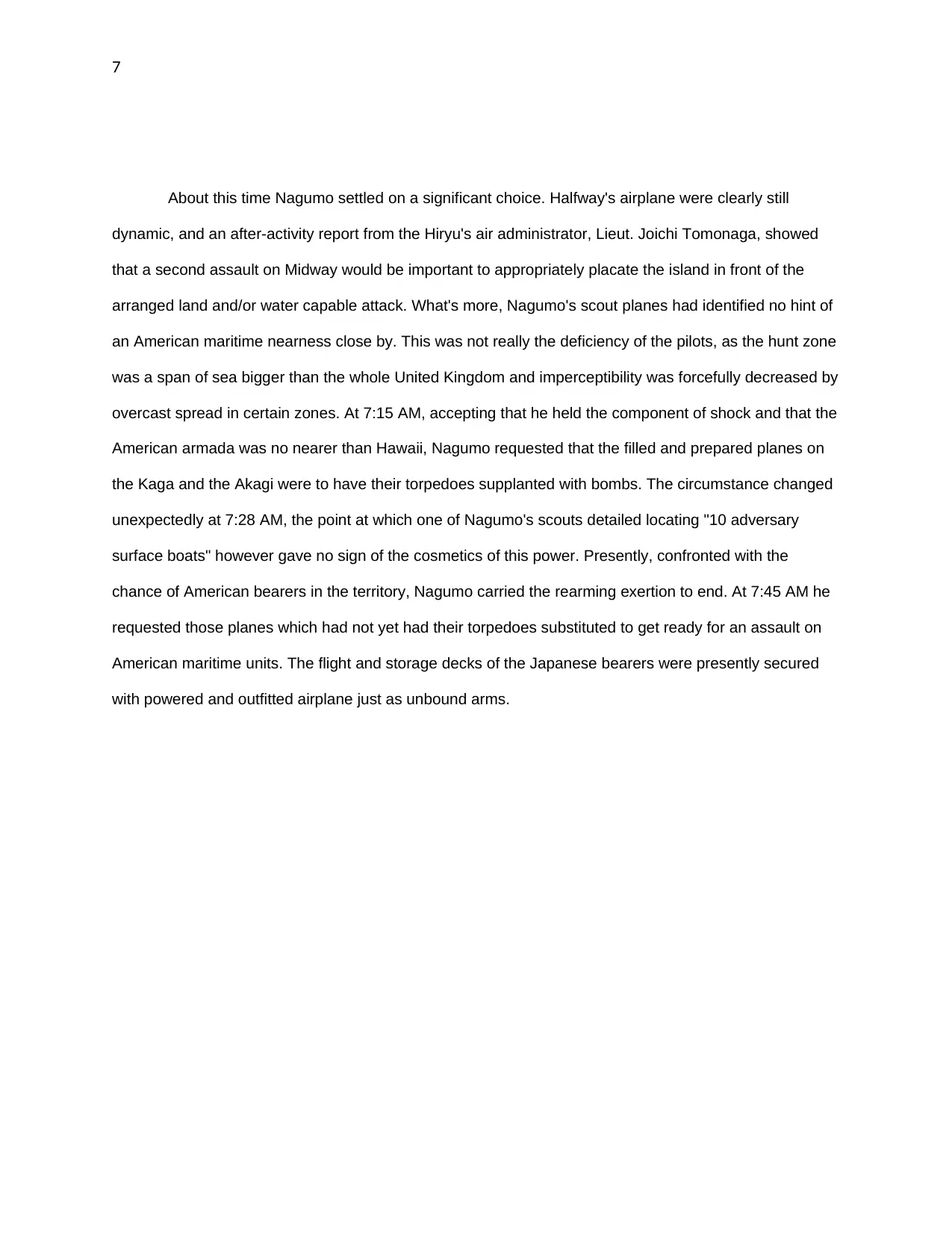
7
About this time Nagumo settled on a significant choice. Halfway's airplane were clearly still
dynamic, and an after-activity report from the Hiryu's air administrator, Lieut. Joichi Tomonaga, showed
that a second assault on Midway would be important to appropriately placate the island in front of the
arranged land and/or water capable attack. What's more, Nagumo's scout planes had identified no hint of
an American maritime nearness close by. This was not really the deficiency of the pilots, as the hunt zone
was a span of sea bigger than the whole United Kingdom and imperceptibility was forcefully decreased by
overcast spread in certain zones. At 7:15 AM, accepting that he held the component of shock and that the
American armada was no nearer than Hawaii, Nagumo requested that the filled and prepared planes on
the Kaga and the Akagi were to have their torpedoes supplanted with bombs. The circumstance changed
unexpectedly at 7:28 AM, the point at which one of Nagumo's scouts detailed locating "10 adversary
surface boats" however gave no sign of the cosmetics of this power. Presently, confronted with the
chance of American bearers in the territory, Nagumo carried the rearming exertion to end. At 7:45 AM he
requested those planes which had not yet had their torpedoes substituted to get ready for an assault on
American maritime units. The flight and storage decks of the Japanese bearers were presently secured
with powered and outfitted airplane just as unbound arms.
About this time Nagumo settled on a significant choice. Halfway's airplane were clearly still
dynamic, and an after-activity report from the Hiryu's air administrator, Lieut. Joichi Tomonaga, showed
that a second assault on Midway would be important to appropriately placate the island in front of the
arranged land and/or water capable attack. What's more, Nagumo's scout planes had identified no hint of
an American maritime nearness close by. This was not really the deficiency of the pilots, as the hunt zone
was a span of sea bigger than the whole United Kingdom and imperceptibility was forcefully decreased by
overcast spread in certain zones. At 7:15 AM, accepting that he held the component of shock and that the
American armada was no nearer than Hawaii, Nagumo requested that the filled and prepared planes on
the Kaga and the Akagi were to have their torpedoes supplanted with bombs. The circumstance changed
unexpectedly at 7:28 AM, the point at which one of Nagumo's scouts detailed locating "10 adversary
surface boats" however gave no sign of the cosmetics of this power. Presently, confronted with the
chance of American bearers in the territory, Nagumo carried the rearming exertion to end. At 7:45 AM he
requested those planes which had not yet had their torpedoes substituted to get ready for an assault on
American maritime units. The flight and storage decks of the Japanese bearers were presently secured
with powered and outfitted airplane just as unbound arms.
Paraphrase This Document
Need a fresh take? Get an instant paraphrase of this document with our AI Paraphraser
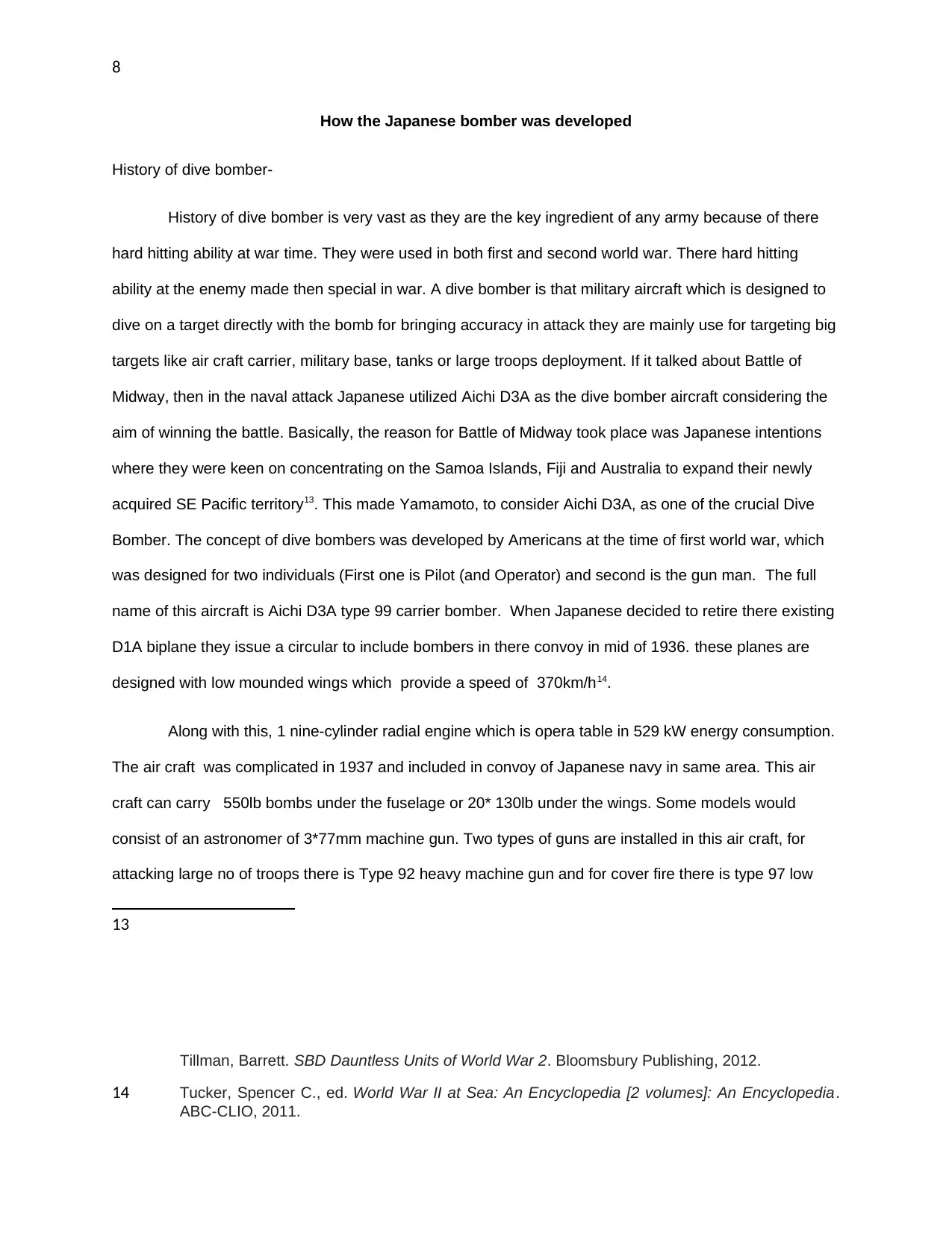
8
How the Japanese bomber was developed
History of dive bomber-
History of dive bomber is very vast as they are the key ingredient of any army because of there
hard hitting ability at war time. They were used in both first and second world war. There hard hitting
ability at the enemy made then special in war. A dive bomber is that military aircraft which is designed to
dive on a target directly with the bomb for bringing accuracy in attack they are mainly use for targeting big
targets like air craft carrier, military base, tanks or large troops deployment. If it talked about Battle of
Midway, then in the naval attack Japanese utilized Aichi D3A as the dive bomber aircraft considering the
aim of winning the battle. Basically, the reason for Battle of Midway took place was Japanese intentions
where they were keen on concentrating on the Samoa Islands, Fiji and Australia to expand their newly
acquired SE Pacific territory13. This made Yamamoto, to consider Aichi D3A, as one of the crucial Dive
Bomber. The concept of dive bombers was developed by Americans at the time of first world war, which
was designed for two individuals (First one is Pilot (and Operator) and second is the gun man. The full
name of this aircraft is Aichi D3A type 99 carrier bomber. When Japanese decided to retire there existing
D1A biplane they issue a circular to include bombers in there convoy in mid of 1936. these planes are
designed with low mounded wings which provide a speed of 370km/h14.
Along with this, 1 nine-cylinder radial engine which is opera table in 529 kW energy consumption.
The air craft was complicated in 1937 and included in convoy of Japanese navy in same area. This air
craft can carry 550lb bombs under the fuselage or 20* 130lb under the wings. Some models would
consist of an astronomer of 3*77mm machine gun. Two types of guns are installed in this air craft, for
attacking large no of troops there is Type 92 heavy machine gun and for cover fire there is type 97 low
13
Tillman, Barrett. SBD Dauntless Units of World War 2. Bloomsbury Publishing, 2012.
14 Tucker, Spencer C., ed. World War II at Sea: An Encyclopedia [2 volumes]: An Encyclopedia.
ABC-CLIO, 2011.
How the Japanese bomber was developed
History of dive bomber-
History of dive bomber is very vast as they are the key ingredient of any army because of there
hard hitting ability at war time. They were used in both first and second world war. There hard hitting
ability at the enemy made then special in war. A dive bomber is that military aircraft which is designed to
dive on a target directly with the bomb for bringing accuracy in attack they are mainly use for targeting big
targets like air craft carrier, military base, tanks or large troops deployment. If it talked about Battle of
Midway, then in the naval attack Japanese utilized Aichi D3A as the dive bomber aircraft considering the
aim of winning the battle. Basically, the reason for Battle of Midway took place was Japanese intentions
where they were keen on concentrating on the Samoa Islands, Fiji and Australia to expand their newly
acquired SE Pacific territory13. This made Yamamoto, to consider Aichi D3A, as one of the crucial Dive
Bomber. The concept of dive bombers was developed by Americans at the time of first world war, which
was designed for two individuals (First one is Pilot (and Operator) and second is the gun man. The full
name of this aircraft is Aichi D3A type 99 carrier bomber. When Japanese decided to retire there existing
D1A biplane they issue a circular to include bombers in there convoy in mid of 1936. these planes are
designed with low mounded wings which provide a speed of 370km/h14.
Along with this, 1 nine-cylinder radial engine which is opera table in 529 kW energy consumption.
The air craft was complicated in 1937 and included in convoy of Japanese navy in same area. This air
craft can carry 550lb bombs under the fuselage or 20* 130lb under the wings. Some models would
consist of an astronomer of 3*77mm machine gun. Two types of guns are installed in this air craft, for
attacking large no of troops there is Type 92 heavy machine gun and for cover fire there is type 97 low
13
Tillman, Barrett. SBD Dauntless Units of World War 2. Bloomsbury Publishing, 2012.
14 Tucker, Spencer C., ed. World War II at Sea: An Encyclopedia [2 volumes]: An Encyclopedia.
ABC-CLIO, 2011.

9
machine gun. But, these Japanese planes were got caught within the Battle of Midway where they got
destroyed by antiaircraft missiles and left the trails of smoke and flame as it falls toward the ocean. The
pilot might have already been dead by the time the bomber was going down; getting knocked out would
probably be a small mercy compared to being burnt alive or drowning. There’s a passage from an
autobiography of a Second World War British bomber crew member called “In for a Penny, in for a
Pound”: he describes that if they were to survive a crash but find themselves completely stuck in a
burning wreck, they were instructed to stick their face in the flames and breath in. Their lungs would be
incinerated from the heat, making them pass out, allowing a quicker and less painful death than being
burned alive.
Results of the battle
It was that battle which is decisive in nature and will only end with the surrender of one military.
Japanese military fought this battle with a planed strategy but in the end they have to loose by sacrificing
there all four aircraft carrier and a large number of troops. The Japanese bomber play there role
effectively but the American cryptographers ready for this attack and this leads in loose of japan in the
battle of midway . Many American planes also play an important role in victory of America in the war if
midway. The plan used by American Military was to that their carriers were specifically divided among
different groups (two groups) where the Task Force 16, consists of Enterprise along with Hornet. This was
specifically taken into consideration of Halsey’s replacement, Rear Administration. Including this, it is also
said that Raymond Spruance was taken into consideration of Task Force 17, where it mainly utilized
Yorktown which was under Rear Adm. Frank Jack Fletcher. Including this, just because of seniority within
the rank system, Mr. Fletcher had specific tactical command. This is where, he specifically delivered all
the decisions Spruance where it was important to handle the operational latitude. This was taken into
consideration but it was also fortunate, just because of various reasons like Spruance was one of finest
American naval commander in the World War II. Specifically, it was the loss of Japan, where it was
surprised by Yorktown’s Devastators which was unique in nature as it was the only torpedo squadron that
has helped in winning the Battle of Midway as a fighter escort. Including this, it was mentioned that more
than half-dozen Grumman F4F Wildcats in relation with Yorktown worked as slow-moving Devastators.
machine gun. But, these Japanese planes were got caught within the Battle of Midway where they got
destroyed by antiaircraft missiles and left the trails of smoke and flame as it falls toward the ocean. The
pilot might have already been dead by the time the bomber was going down; getting knocked out would
probably be a small mercy compared to being burnt alive or drowning. There’s a passage from an
autobiography of a Second World War British bomber crew member called “In for a Penny, in for a
Pound”: he describes that if they were to survive a crash but find themselves completely stuck in a
burning wreck, they were instructed to stick their face in the flames and breath in. Their lungs would be
incinerated from the heat, making them pass out, allowing a quicker and less painful death than being
burned alive.
Results of the battle
It was that battle which is decisive in nature and will only end with the surrender of one military.
Japanese military fought this battle with a planed strategy but in the end they have to loose by sacrificing
there all four aircraft carrier and a large number of troops. The Japanese bomber play there role
effectively but the American cryptographers ready for this attack and this leads in loose of japan in the
battle of midway . Many American planes also play an important role in victory of America in the war if
midway. The plan used by American Military was to that their carriers were specifically divided among
different groups (two groups) where the Task Force 16, consists of Enterprise along with Hornet. This was
specifically taken into consideration of Halsey’s replacement, Rear Administration. Including this, it is also
said that Raymond Spruance was taken into consideration of Task Force 17, where it mainly utilized
Yorktown which was under Rear Adm. Frank Jack Fletcher. Including this, just because of seniority within
the rank system, Mr. Fletcher had specific tactical command. This is where, he specifically delivered all
the decisions Spruance where it was important to handle the operational latitude. This was taken into
consideration but it was also fortunate, just because of various reasons like Spruance was one of finest
American naval commander in the World War II. Specifically, it was the loss of Japan, where it was
surprised by Yorktown’s Devastators which was unique in nature as it was the only torpedo squadron that
has helped in winning the Battle of Midway as a fighter escort. Including this, it was mentioned that more
than half-dozen Grumman F4F Wildcats in relation with Yorktown worked as slow-moving Devastators.
⊘ This is a preview!⊘
Do you want full access?
Subscribe today to unlock all pages.

Trusted by 1+ million students worldwide
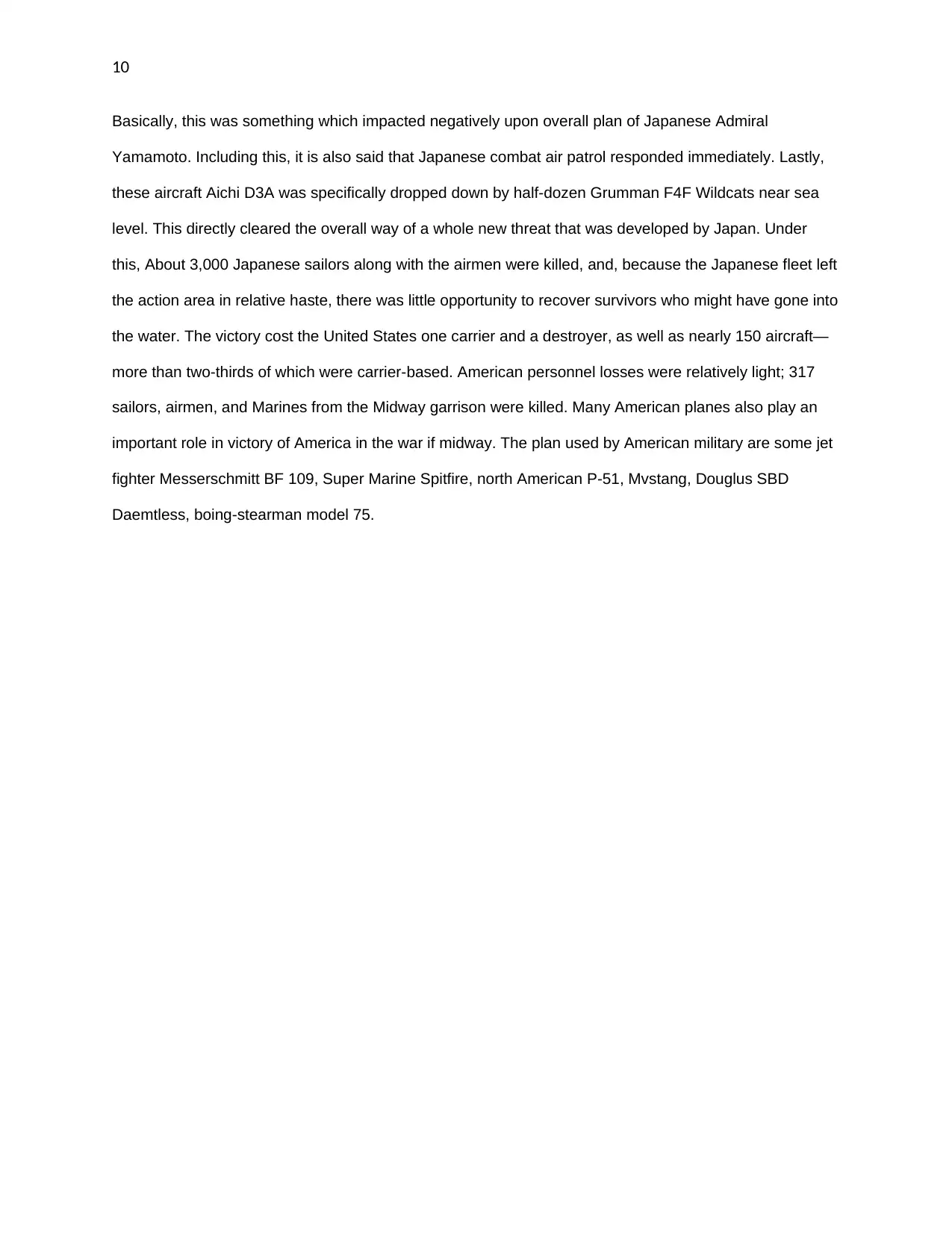
10
Basically, this was something which impacted negatively upon overall plan of Japanese Admiral
Yamamoto. Including this, it is also said that Japanese combat air patrol responded immediately. Lastly,
these aircraft Aichi D3A was specifically dropped down by half-dozen Grumman F4F Wildcats near sea
level. This directly cleared the overall way of a whole new threat that was developed by Japan. Under
this, About 3,000 Japanese sailors along with the airmen were killed, and, because the Japanese fleet left
the action area in relative haste, there was little opportunity to recover survivors who might have gone into
the water. The victory cost the United States one carrier and a destroyer, as well as nearly 150 aircraft—
more than two-thirds of which were carrier-based. American personnel losses were relatively light; 317
sailors, airmen, and Marines from the Midway garrison were killed. Many American planes also play an
important role in victory of America in the war if midway. The plan used by American military are some jet
fighter Messerschmitt BF 109, Super Marine Spitfire, north American P-51, Mvstang, Douglus SBD
Daemtless, boing-stearman model 75.
Basically, this was something which impacted negatively upon overall plan of Japanese Admiral
Yamamoto. Including this, it is also said that Japanese combat air patrol responded immediately. Lastly,
these aircraft Aichi D3A was specifically dropped down by half-dozen Grumman F4F Wildcats near sea
level. This directly cleared the overall way of a whole new threat that was developed by Japan. Under
this, About 3,000 Japanese sailors along with the airmen were killed, and, because the Japanese fleet left
the action area in relative haste, there was little opportunity to recover survivors who might have gone into
the water. The victory cost the United States one carrier and a destroyer, as well as nearly 150 aircraft—
more than two-thirds of which were carrier-based. American personnel losses were relatively light; 317
sailors, airmen, and Marines from the Midway garrison were killed. Many American planes also play an
important role in victory of America in the war if midway. The plan used by American military are some jet
fighter Messerschmitt BF 109, Super Marine Spitfire, north American P-51, Mvstang, Douglus SBD
Daemtless, boing-stearman model 75.
Paraphrase This Document
Need a fresh take? Get an instant paraphrase of this document with our AI Paraphraser
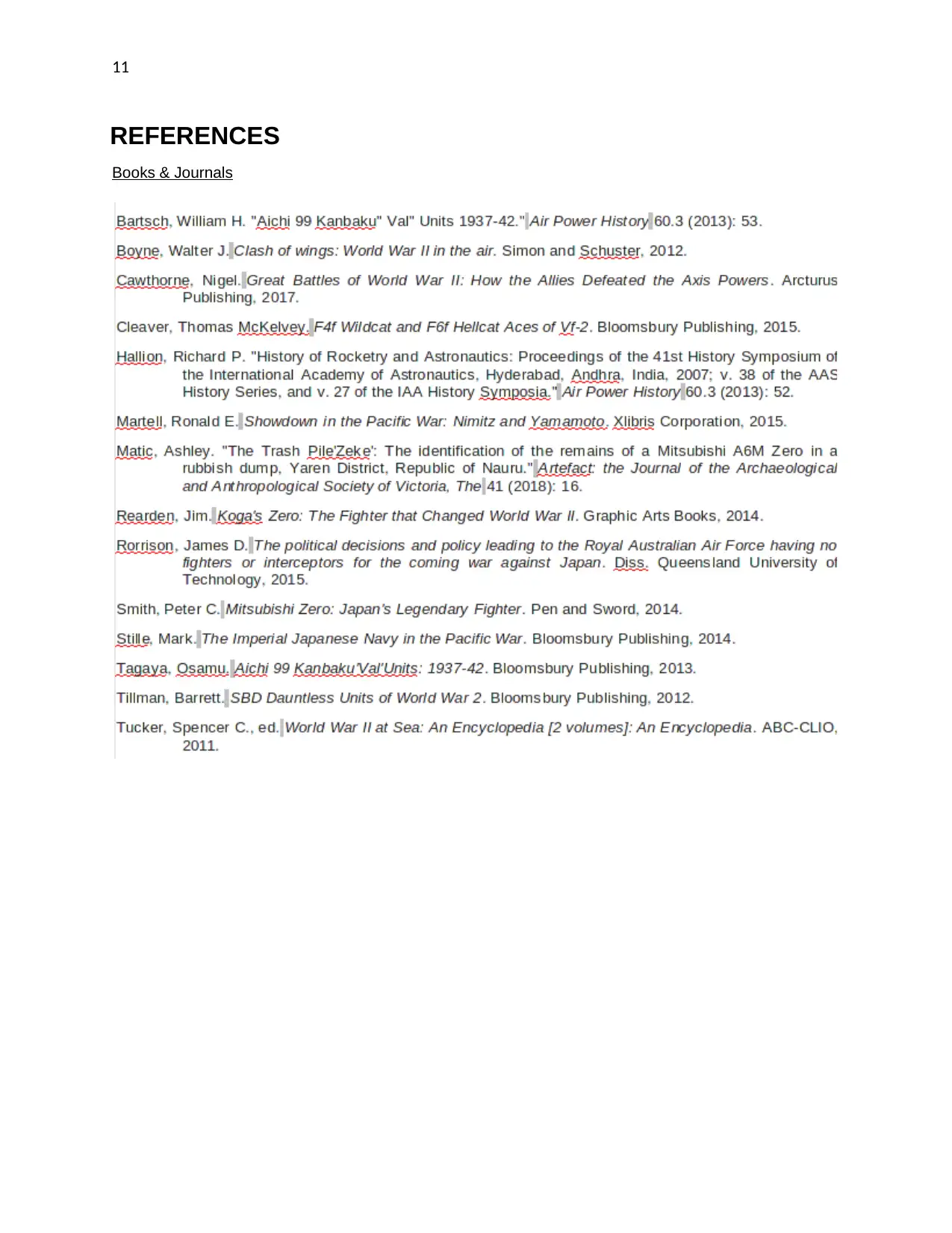
11
REFERENCES
Books & Journals
REFERENCES
Books & Journals
1 out of 11
Related Documents
Your All-in-One AI-Powered Toolkit for Academic Success.
+13062052269
info@desklib.com
Available 24*7 on WhatsApp / Email
![[object Object]](/_next/static/media/star-bottom.7253800d.svg)
Unlock your academic potential
Copyright © 2020–2025 A2Z Services. All Rights Reserved. Developed and managed by ZUCOL.





